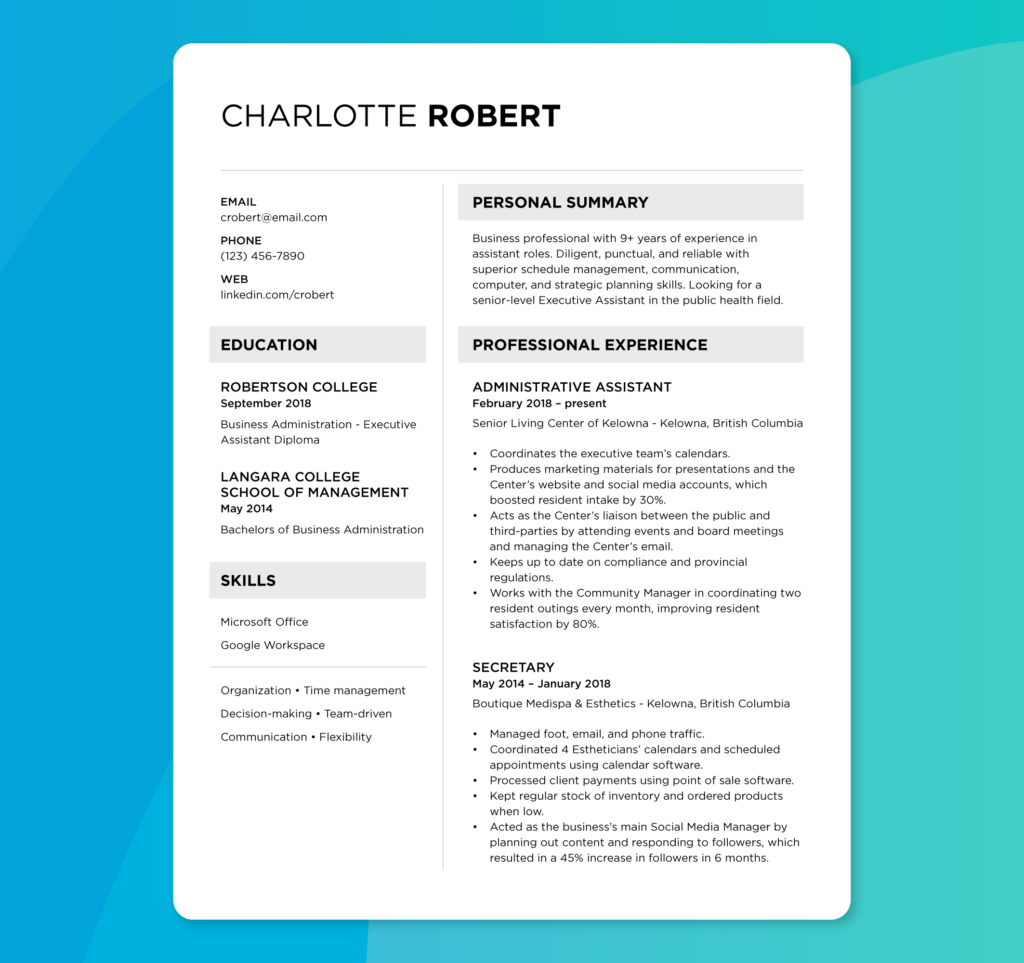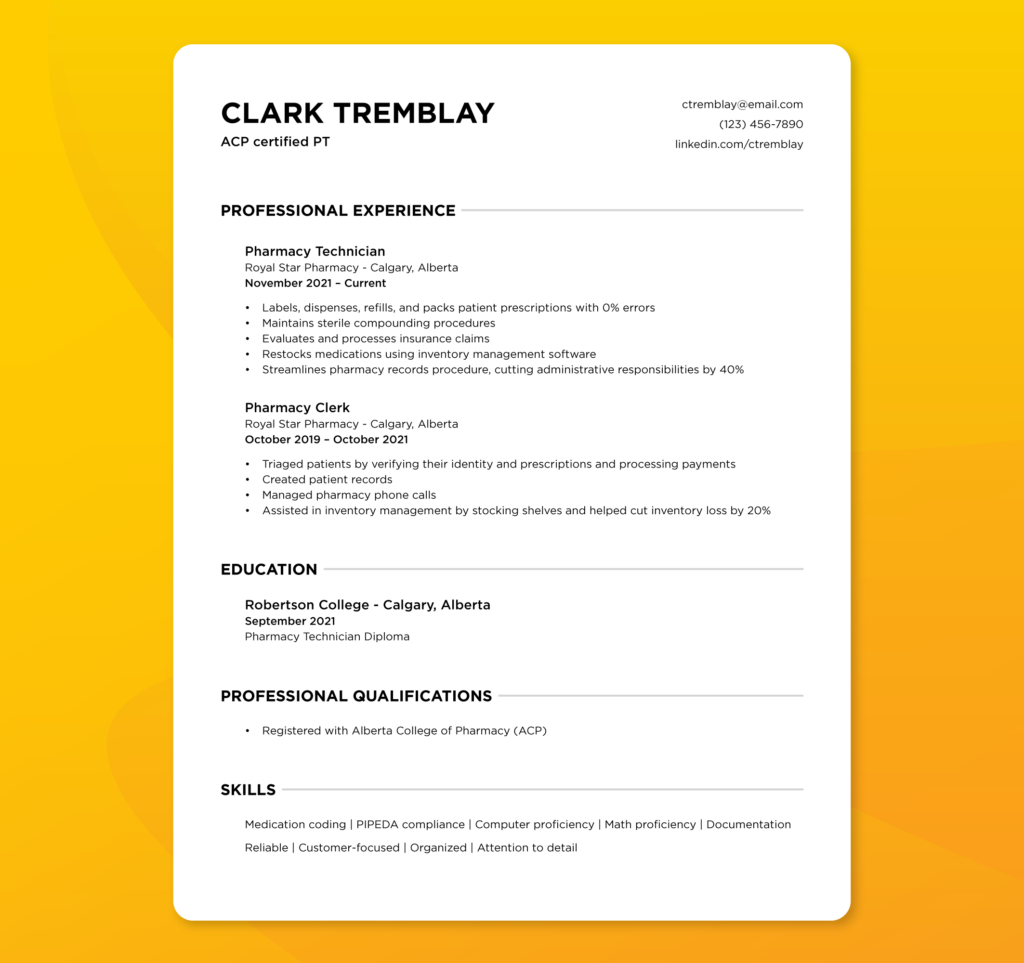Career Tips
Canadian Resume: Format, Types And Free Templates

Gotten the Canadian job of your dreams? Update your resume. We cover Canadian resume types and offer free templates.
Writing a resume might be intimidating. It can take eight hours to polish and engage the recruiter or manager reading it. Perfectionism might make it hard to find terms that showcase your job and skills.
Luckily, we offer free Canadian resume templates. Let’s discuss the Canadian resume format, what to avoid, and four customizable resume templates.
Parts of the Canadian Resume Format
Let’s break down the five must-hit components of the Canadian resume format and tips on how to make your resume stand out from the rest.

1. Header
The header is the first thing you see when looking at a resume. It’s front and center at the very top and includes your personal information and contact details.
A header should include your:
- Name
- Post-nominal abbreviations for qualifications and accreditations
- Phone number
- Professional email address
- City and province
- LinkedIn profile link (optional)
Leave out potentially discriminatory facts like:
- Religion
- Ethnicity
- Age
- Marital status
- Sexual orientation
- Disability
Photos are becoming increasingly common in resumes, but we recommend leaving them out of the header. Recruiters reject 88 percent of resumes that include photos.
TIP: Keep a version as a template with all of your experience. If you need to cut out irrelevant information, it’s nice to have a backup of your original.
2. Professional Summary
The optional professional or personal summary is located beneath the header. This is a paragraph in which you can give your elevator pitch for your career.
It is entirely up to you whether or not to include a professional summary. Some industries and companies may regard this as outdated, but if you’re starting out or changing fields, it could be a beneficial addition. Keep your personal summary professional – leave out personal elements like hobbies because 79% of employers skip over them.
TIP: Reverse chronological order of job history is the most common Canadian resume format. Functional order is another option that prioritizes skills over employment history.
3. Work Experience
Work history takes up the bulk of your resume. So when you’re writing this section, keep these tips in mind for each position:
- Include your job title, employer, location, and employment dates.
- List out your job responsibilities and achievements in bullets. Prioritize achievements over general job duties.
- Use numbers and specifics to describe your accomplishments.
- Incorporate keywords found in the job description to pass through applicant tracking software.
TIP: Keep it simple, organized, and skimmable.
4. Education
Keep education brief on a CV because it shouldn’t overshadow professional experience. List the institution, degree, and specialty. Exclude your high school diploma if you went to college.
Including your GPA is optional. If you graduated recently and want to show off, feel free.
TIP: Write your resume for the job you want, not the job you have.
5. Skills
You can include skills in your work experience or add a skills section to your CV. Software experience and soft skills like problem-solving should be included. If applicable. mention job description keywords here(i this section).
Modern resumes grade skills or show competence. We suggest mentioning only your strongest skills and omitting your worst.
TIP: Attach your resume as a PDF on job applications.
Industry-Specific Resume Templates
You may create a résumé now that you know what to include.
Industry-specific resume formats apply. Keep your resume traditional for finance and healthcare. Color, typography, and layout may reflect personality in creative careers like graphic design and advertising. Your CV can stand out by showing personality. However, don’t overdo it—your CV should be clear and succinct.
Use one of these four Canadian resume templates to impress hiring managers.
Business Resume Template
You should format business resumes in a traditional layout with a common black font.. Include industry certificates and awards when applying for business jobs. When applying for corporate jobs, hiring managers employ technologies to screen applicants.
Our business resume template works for:
- Financial Analyst
- Accountant
- Human Resource Coordinator
- Operations Manager
- Sales Representative
- Business Development Officer
However, a traditional format like our business resume template is safe for any job.

Health Care Resume Template
A standard/traditional resume is also appropriate for health care workers. Hospitals, for example, receive a large number of applicants and expect to see resumes that seem similar.
Our health care resume template can be used for positions such as:
- Pharmacists or Pharmacy Technicians
- Registered Nurses or Nursing Assistants
- Physician Assistants
- Health Care Aides
- Massage Therapists
- Health Care Administrators
When writing your health care resumes, prioritize your licensure, certifications, and education.

Education Resume Template
Your resume could showcase your creativity as a teacher. A teaching resume should still be fairly traditional regarding what you include, but you can show your personality using Color, fonts, and style may express your personality on a teaching resume. Your resume design shouldn’t overshadow your qualifications.
You can use our education resume template for jobs like:
- Early Childhood Educators
- Education Administrators
- Primary or Secondary School Teachers
- Teacher Assists
- Post-secondary Professors
- Recreation Program Leaders
If you’ve worked as a Substitute Teacher, Coach, Camp Counselor, or anything similar, those roles can make great work history examples for those starting their careers.

Technology Resume Template
Tech companies and occupations are broad. This broad sector needs data analysis, computer tech assistance, and entry-level cybersecurity abilities. Tech professions, like teaching, require creativity, which your resume can demonstrate.
You can use our technology resume template for positions like:
- Software Engineers
- Web Developers
- Computer Support Technicians
- Cyber Security Officers
- DevOps Director
If you’re applying for a tech position with an established company, you should use a traditional resume format such as our business resume template above. Startups, on the other hand, are likely to be lot more relaxed and love to see unusual CV styles.

4 Common Resume Mistakes
If you’re applying for job after job and your qualifications meet each job description but aren’t receiving as much as a phone interview, you might want to reassess your resume. You could be making one of these four common resume mistakes.
1. Your Resume Has Spelling and Grammar Errors
Your resume must be properly grammatically correct. Spelling errors and bad grammar indicate a lack of effort or writing talent. Although it may appear clear, this is a common yet avoidable error.
Also, try to use an energetic voice. Active voice helps cut out unnecessary words and improves sentence structure for reading comprehension.
2. Your Resume is Too Long
A single job opening receives about 250 applications, and recruiters spend an average of 7.4 seconds reviewing a single resume. So, it’s important to keep your resume on one page. This means everything on your resume should add value and showcase your accomplishments and talents.
3. You Undersell Yourself
Hiring managers make initial impressions of you based on your résumé. While you should avoid exaggerating or lying about your skills, you must market yourself. Include your most notable accomplishments in relation to the job you’re looking for.
A good rule of thumb — ask yourself, “Would I want to interview myself based on this resume?”
4. Your Resume Descriptions Are Too Vague
You may sell yourself in your work experience descriptions. Vague descriptions loaded with excessively general responsibilities and jargon can be misconstrued as filler stuff.
Make an effort to be specific. Instead of writing, “Managed a team of 20 people,” say, “Decreased employee turnover by 20% by re-assessing benefits and conducting biweekly one-on-one check-ins.”
FAQs
Does My Resume Need To Be Different For Each Job?
Tailoring your CV to the job is preferable. That doesn’t mean your CV must be different for every job. To match your talents to the job, make tiny changes. Only alter your resume if you’re applying for a different job.
However, cover letters should vary every job. Thus, tailor your cover letter to the specific company and role.
Should I Put My Address On My Resume?
There’s no reason a company should need personal details such as your physical address or social insurance number unless they hire you. You do not need to put your full address on your resume. At most, include your city and postal code.
Should I Include an Objective Statement On My Resume?
Personal preference dictates whether an objective statement or professional summary is included. It’s completely fine to include or exclude this step from your resume.
Some businesses consider resume objectives to be an obsolete and superfluous practice. Many employers still need cover letters, which elaborate on the same issue as a resume aim.
How Many Jobs Should Be On My Resume?
No specific number of jobs is needed on a resume because most companies care about how long you’ve worked in the field. However, list at least two jobs. Start your career with practicum or internship experiences. One-page resumes are best.
If the job doesn’t demand more than 10 to 15 years of experience, don’t include it.
Should I Leave Out Irrelevant Experience?
To keep your resume brief, simply list the most relevant experience for each job. You can leave out irrelevant experience on your CV. Just be ready to explain resume gaps in an interview.
If you have no relevant or limited work history, you can mention irrelevant jobs to show professional experience.
Should I Add Volunteer Work To My Resume?
Adding volunteer work on your CV can be a good way to round out your resume, but it is not required. A For volunteer experience within your field, add it to your work experience. If it’s unimportant or you have a lot of jobs, mentioned, list your volunteer work separately(in a separate section).
Are Resumes and CVs The Same Thing?
Resumes and curriculum vitae (CV) are similar, but CVs are longer and typically reserved for those with Master’s Degrees or Doctorates applying for teaching, research, medical, and science positions.






















